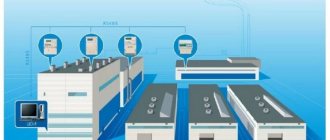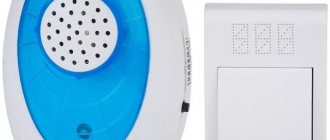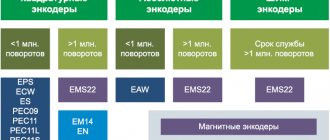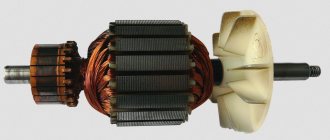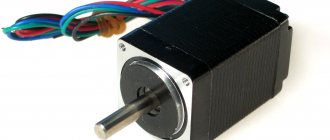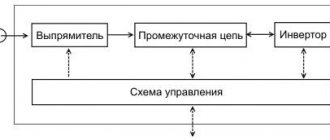Explanation ASTUE is an automated system for technical metering of electricity.
The system is designed for operational analysis and reliable information on electricity and power consumption at industrial enterprises, oil and gas production facilities, housing and communal services, etc.
The system serves to provide:
- Collection and transmission of electrical parameters of the operation of various units, pumping units from installed and designed meters.
- Monitoring power supply parameters modes.
- Accounting for electricity spent for own needs.
- Selecting the mode for the most rational use of electricity.
- Creation of reliable power supply through the timely provision of objective information in the required time period for accounting and analysis of effective energy consumption.
- Planning the consumption of energy resources over a long period of time, promptly, identifying the causes and cases of inefficient use of electricity.
Explanation of the abbreviation ASKUE
The name is deciphered as follows:
- A – automated.
- S – system.
- K – commercial.
- U-accounting.
- E – electricity.
Sometimes a clarification is added to the name to describe the nature of the complex - “information-measuring”. In this case, the abbreviation is transformed into AIIS KUE or AISKUE.
Among the accepted abbreviations you can find consonant names, for example: ASDUE or ASTUE, but these are completely different automation complexes. The first provides dispatch control of power supply (DUE), while the second, although it is an accounting system, has a technical rather than a commercial component. The differences between these speakers will be discussed in detail below.
What are the advantages of ASTUE
Electricity metering is needed to extract the necessary information about the amount of energy and power consumed.
Every year, professionals want to automate this process, making it less labor-intensive, but at the same time more reliable. This process led to the introduction of the latest modern ASTUE system. ASTUE eliminates labor costs and the human factor, which contributes to both the creation of an erroneous incident and the correction of errors in automated production.
Automation creates additional opportunities related to monitoring, assessing the health status of the accounting system, and identifying faults. In addition, the system ensures safety and long-term storage of the received data.
Functions of the ASKUE system and its purpose
The functional purpose of this complex is to automate the process of accounting for electricity consumption to make settlements with its consumers. In addition, based on the collected information, the AS generates a number of reports used in constructing consumption forecasts, calculating cost indicators, etc.
To perform the tasks listed above, the following conditions must be met:
- Each electricity consumer must install an electronic meter equipped with a signal transmission module (for example, a GSM modem).
Electronic electricity meter Energomera, equipped with an interface for data transfer. - A communication system that ensures the transmission of signals from metering devices to their processing center.
Types of communication of ASKUE systems - Organization of data reception and processing centers. These are hardware and software complexes (hereinafter referred to as HPC).
One of the elements of the hardware and software complex is the ASKUE cabinet - In some cases, special devices are installed between the receiving center and the metering devices - adders, in which data is “accumulated” before it is sent to the server.
Software product for data collection and equipment management (including NBIoT)
Currently, we have developed a unique proposal for building any dispatching and telemechanics systems, both using conventional communication means for instrumentation and automation, and using the new NBIoT , which allows us to qualitatively improve the range of an object and reduce the cost of maintaining such equipment. In addition, we can manage equipment over NBIoT . Please check out our new universal software product “My Client: Resources”.
Operating principle of ASKUE
The operating algorithm of the complex can be described as follows:
- Electronic meters (Mercury, Energomera, etc.) send a signal simultaneously. The frequency (periodicity) of data transmission is determined by the AC.
- Data is archived in adders, from where they are transferred to the collection and processing server. In an unloaded AS, transmission directly to the server is allowed.
- Processing of agro-industrial complex data.
Actually, this operating algorithm is used in all energy metering and control systems. The difference between automated complexes lies in their functional purpose, which is reflected in analysis and processing. As an example, here are the differences between commercial and technical systems (ASTUE):
- The data processing algorithm for settlements with consumers is maximally optimized for this task.
- The data received by the commercial processing center is used to generate bills for consumers, that is, in essence, it is an internal “product” of the energy company.
- According to the law, all consumers are required to have metering meters, while the ASTUE system is being implemented to solve the internal problems of a particular business entity. For example, to monitor energy consumption, analyze its structure and develop a general energy-saving program and other tasks of automated process control systems.
To understand the structure of commercial accounting systems, we provide several examples of implementation schemes.
ASKUE scheme in SNT
As you can see in this diagram, the metering devices installed at each consumer transmit signals to the adder, from where transmission is carried out to the processing center. This implementation is practiced in holiday villages and gardening
Please note that such an AC can be used both to measure the consumption of electricity (electric current) and cold and hot water. An example of such an implementation in a residential building is shown below.
Scheme of the ASKUE system at home
Basic elements of ASKUE
As you can see, the automated accounting system includes a number of elements (divisions) that perform certain tasks. Such a structure is usually divided into three levels. Let's talk in detail about the purpose of each of them.
First level elements
These include electronic metering devices that have a special module that allows you to send signals to the collection center. In Russia, the practice is to use the RS-485 interface; this is a standard for asynchronous data transfer used in automation systems. Its simplified organization is presented below.
Organization of the RS-485 interface
The main disadvantage of such a device is the limitation on the number of transceivers; there cannot be more than 32. A way out of this could be cascading the system, namely the installation of adders that “accumulate” data from various sources. An image of such a device is shown in Figure 7.
Figure 7. Data acquisition and transmission device (DCD)
Please note that the development of speakers based on the RS-485 interface was carried out at a time when the use of GSM was not economically justified. Currently, the situation has changed radically.
Connecting link (second level elements)
This level is used to organize data transportation to the processing center. Currently, most metering devices use the RS-485 interface, despite the fact that this method is clearly outdated. The current situation is caused by the inertia of the structures responsible for standardization, which somewhat slows down the implementation of the new technical base.
Processing center (final link)
This element is an automated complex into which information signals are received and processed. Its characteristics directly depend on the volume of incoming data and the availability of additional system functions. Based on these technical conditions, computer power and software are selected for the NPP complex.
About technical requirements for the system
Since the reliability of the system directly depends on the first level, the main requirements are imposed on metering devices. It is their accuracy that determines the reliability of the data.
An equally important indicator of the system is the permissible error during data transfer. This point requires a little clarification. The telemetry output of the device transmits a sequence of pulses with a frequency corresponding to the power consumption. Interference and thermal noise can introduce errors into such data, that is, affect the pulse report.
To avoid this, information is transmitted in binary code, with high and low signal impedance corresponding to "1" and "0". To check the reliability of data, a certain portion of it (usually a byte) is encoded with a checksum.
There is an opinion that the digital form of transmission is protected from errors. This statement is not correct, since the transmission protocol allows for a certain probability of error (undetected error). Actually, this drawback, to one degree or another, is inherent in any data transmission system. To reduce the size of the permissible error, special processing algorithms are used.
Companies involved in the development of AS are required to adhere to the standard technical requirements developed by the Unified Energy System of the Russian Federation. These standards indicate the accuracy characteristics of the information signal, the accuracy class of metering devices, recommended software, as well as other requirements necessary for reliable operation of the system. Accordingly, manufacturers of measuring instruments must also take into account the accepted standards.
What is an “automated workstation” (AWS)
An automated workstation is a mandatory component of ASTUE. Thanks to it, you can regularly record readings and create graphs for a detailed analysis of an entire enterprise or any specific chain of activities connected to the network.
Using such graphs, you can track energy consumption over time and even make a forecast for the future consumption of specific devices.
Such software is extremely necessary for large enterprises, which are required to draw up a plan for further activities and timely submit applications for a certain amount of electricity to the relevant electricity supply organizations.
Implementation
Installation of ASKUE systems is carried out according to the following algorithm:
- Creation of a working project, where the structure of the system and its individual levels are developed, a drawing and other related design documentation are drawn up.
- A data transmission system is selected, taking into account the advantages, disadvantages and possibilities of technical implementation.
- Based on the project estimate, the necessary equipment is purchased.
- Installation and configuration (adjustment) of the agro-industrial complex is carried out.
- The staff is selected and, if necessary, trained.
- Putting the system into operation.
Please note that savings on the project will immediately affect functionality. Due to shortcomings, the data may differ from the actual readings of energy meters, as a result, the use of such a complex will not be effective.
Short description
ASKUE is an automated system for commercial electricity metering. It was created by experts to make your workflow easier. If a person has just encountered this industry, then in order to perceive and understand the meaning, it is better to consider all the data using the example of an apartment building. Correct installation of ASKUE opens up the possibility for specialists to remotely take readings of electricity meters from each apartment. Data reaches its destination through special lines that are reliably protected by encryption. A special server processes the information.
Skillful use of ASKUE allows you to make important decisions in a short time about changing the operating mode of installed electrical equipment, monitor the current balance, and also carry out operational calculations of energy consumption. The experts themselves claim that the installation of such a system will also be useful at those facilities where numerous points of current consumption are scattered in different places, but are united into one network. A striking example is garage cooperatives, apartment buildings, as well as various suburban villages.
In addition to the household industry, it is impossible to imagine large transport and industrial enterprises, railways and ports, airports and transshipment terminals without ASKUE. If a specialist is only interested in recording readings, then the automated electricity metering system provides an excellent opportunity to collect current data from all installed meters separately within a specified period. Thanks to this, errors in manual rewriting of testimony are eliminated, and there is no need to recruit additional staff who will process the information.

